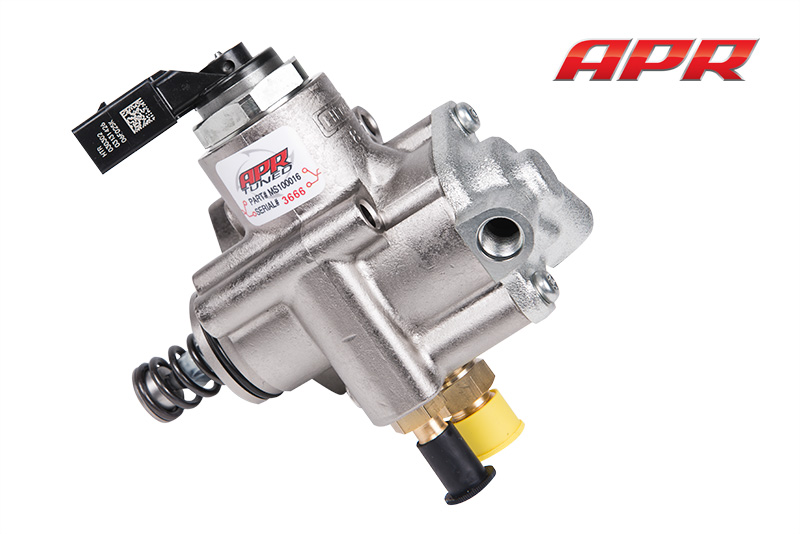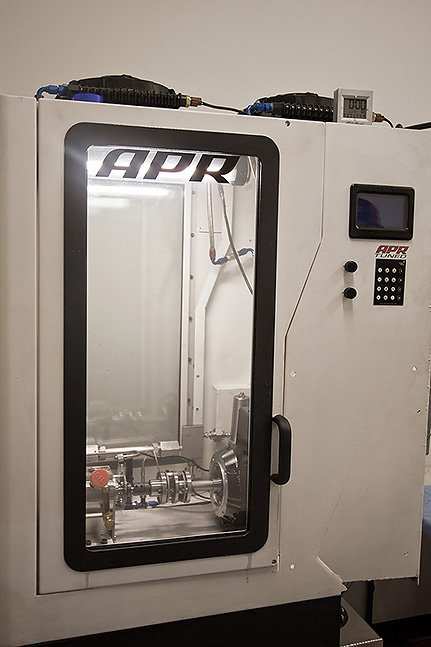APR 2.0T FSI High Pressure Fuel Pump (HPFP)
Modification of the 2.0T FSI engine far beyond OEM power levels requires an additional volume of high-pressure fuel especially in the midrange (3000-5000rpm) of the powerband. To understand why this fuel is needed for the midrange, one must first understand how the fuel delivery system works in the 2.0T FSI.
A low pressure fuel pump, which varies from ~40-95psi, delivers fuel from the gas tank to the high pressure fuel pump. Then the high pressure, camshaft driven pump pressurizes the fuel to upwards of 130bar (almost 1900psi!) in order to spray fuel directly into the combustion chamber. Unfortunately on cars that have many modifications, the stock fuel pump cannot flow enough volume of fuel to maintain the system pressure and the car suffers from the familiar "fuel cut" that so many modified customers experience.
The limitation of how much volume of fuel the high pressure pump can flow is dependent upon the volume displaced by the pressurizing cylinder inside the pump and the number of times the piston reciprocates inside that cylinder. Since the high pressure pump is driven off of the engine camshaft by a three lobe cam the piston of the pump cycles at 1.5 times the engine rpm. (Engine camshaft turns at one-half engine rpm multiplied by three for the number of lobes on the high pressure cam lobe).
Due to this dependency on engine rpm for the high pressure fuel pump output volume, the FSI pump is capable of flowing almost 370hp at 7000 rpm but only 158hp at 3000rpm. The graph below illustrates the maximum horsepower potential of the stock fuel pump compared to the APR FSI fuel pump. Also on the graph are stock and APR Stage III horsepower numbers. Clearly, the stock pump is insufficient for the output generated by this upgraded kit. The only way to address this issue while maintaining a pump that fits in the stock location is to change the volume of the pump's internal pressurization chamber.
Fuel Pump Potential
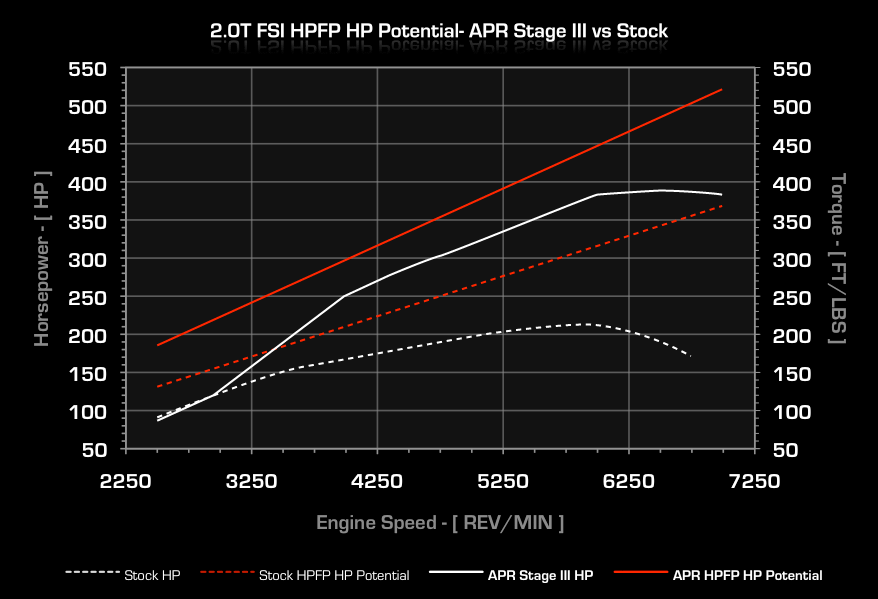
In order to address the lack of fuel in the midrange, the APR FSI fuel pump increases the volume of fuel from the high pressure pump by over 40%. Simplified, this is achieved by modifying some key internal parts within the pump. Changing these components requires precision machining of the new components with special surface treatments as well as enlarged, redesigned seals. Using inferior components on this critical part can lead to many problems from gasoline in the engine oil (from a bad seal) to complete engine failure (from a seized piston in the high pressure pump).
To give an idea of the tolerances involved, the final surface finish on the piston inside the fuel pump is so critical that it can be damaged by touching them with bare hands. The tolerances between the piston and the new barrel the piston rides in can only be measured by a multi-million dollar machine which uses air volumes to measure the part clearances to within microscopic levels.
Fuel Pump Components
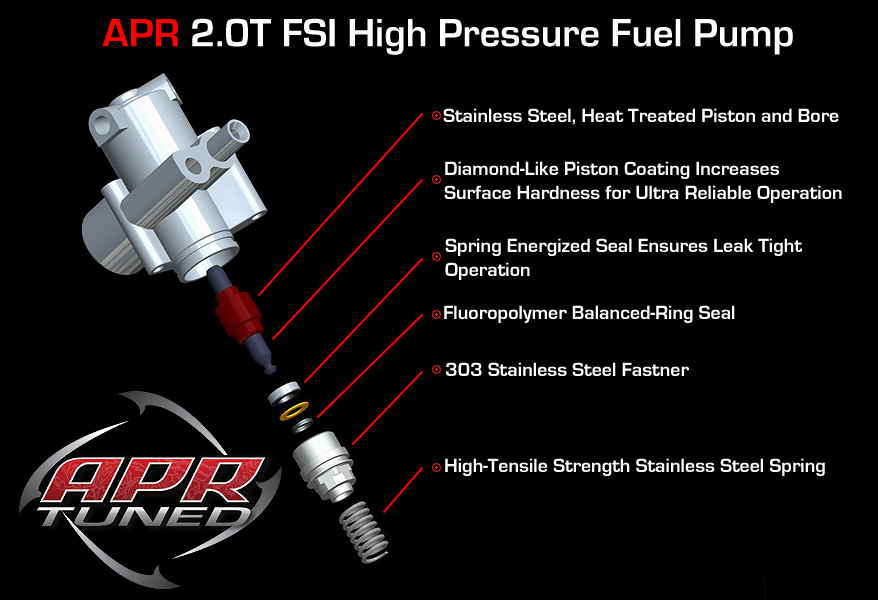
The components used in the APR pump are also of a high caliber. The piston and barrel of the new pump are made of a certified and heat-treated bearing-grade stainless steel and have a special diamond like coating. The seals used in the pump are made of a high performance, filled polymer with a high modulus spring to retain the seal forces throughout the life of the product. The cross section of the seal is also of a proprietary design to maintain integrity over many years of use.
APR FSI pumps have been track tested since 2006 with several hundreds of thousands of miles of combined usage. Each APR pump starts out as a brand new OEM pump and is then modified with the new components by APR and undergoes a rigorous testing process on our high pressure fuel pump tester. Once a pump passes our standards it is serialized and shipped to the customer.
APR HPFP Test Machine
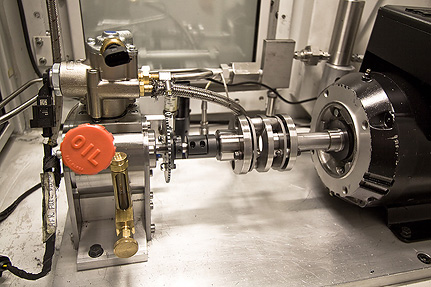
The APR fuel pump tester is a key element in the APR fuel pump production process. With the fuel pump tester we are able to perform several tests to ensure every pump is working to the high standards we have set for it. First the fuel pump tester allows us to perform the critical initial break-in of the new pump. By bringing the pump up to the full operating pressure, we can confirm that the seals in the pump are properly installed and not leaking. We are also able to verify operation of the fuel pump selenoid to ensure the fuel is being injected at the right time and in the right amount. Finally, a performance test is performed to make sure that the pump output is within specifications. This level of quality control ensures a lifetime of worry free miles with an APR FSI high pressure pump.
To ensure flawless drivability the APR 2.0T FSI fuel pump requires APR engine management recalibration to allow for the increased size of the APR fuel pump. Currently, some APR Stage II clients will be able to take advantage of increased horsepower and torque up to 25hp and 35lb ft with APR fuel pump specific engine management performance recalibrations.
Motorsport Development
When it comes to a critical component that can mean the difference between winning a race and not finishing at all, motorsport teams must use the best components available. Motorsport teams around the world have put the APR High Pressure Fuel Pump though brutal and demanding testing and have proven again and again the reliability and performance you can expect from each and every APR High Pressure Fuel Pump. The initial success of the R-GTI and APR's own motorsport team have lead other noteworthy teams around the world to rely on APR.
APR Motorsport

Beginning in 2007, APR Motorsport brutally tested the FSI High Pressure Fuel Pump for thousands of miles at high stress levels. All three race cars successfully completeted their first seasons without a single issue from the APR High Pressure Fuel Pump. The team continues to put each pump though the same brutal testing race after race.
VWMS Scirocco GT24

After seeing the great success of APR's own motorsport team, Volkswagen Motorsport of Germany commissioned APR for their own High Pressure Fuel Pump needs. The 24 hours of Nürburgring is considered to be one of the most demanding endurance races in modern history and knowing that millions of dollars of preparation investment could hinge on the results of such a critical component, VWMS chose to GO APR.
SEAT Sport

APR has accomplished Tier-1 supplier status with SEAT Sport soley due to SEAT's needs for a quality High Pressure Fuel Pump solution. SEAT Sport operates several spec racing leagues throughout several different countries and chances are if you're driving a SEAT 2.0T FSI race car, you've got APR under the hood.
VWGoA R-GTI

Volkswagen Group of America's own R-GTI concept car has more than 430 horsepower and plenty of fueling thanks to an APR Stage III Turbocharger System and the APR High Pressure Fuel Pump. VWGoA relies on APR for the engine performance of their concept car development and this is a great testament to APR's status as the world's leader in VAG performance.
| Year | Model | Engine | Part Number | Price Exc. VAT | Price Inc. VAT | |
|---|---|---|---|---|---|---|
| All | All | 2.0T FSI | MS100016 | £1166.31 | £1399.57 |
